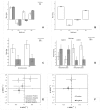Appraisal of space words and allocation of emotion words in bodily space
- PMID: 24349112
- PMCID: PMC3859505
- DOI: 10.1371/journal.pone.0081688
Appraisal of space words and allocation of emotion words in bodily space
Abstract
The body-specificity hypothesis (BSH) predicts that right-handers and left-handers allocate positive and negative concepts differently on the horizontal plane, i.e., while left-handers allocate negative concepts on the right-hand side of their bodily space, right-handers allocate such concepts to the left-hand side. Similar research shows that people, in general, tend to allocate positive and negative concepts in upper and lower areas, respectively, in relation to the vertical plane. Further research shows a higher salience of the vertical plane over the horizontal plane in the performance of sensorimotor tasks. The aim of the paper is to examine whether there should be a dominance of the vertical plane over the horizontal plane, not only at a sensorimotor level but also at a conceptual level. In Experiment 1, various participants from diverse linguistic backgrounds were asked to rate the words "up", "down", "left", and "right". In Experiment 2, right-handed participants from two linguistic backgrounds were asked to allocate emotion words into a square grid divided into four boxes of equal areas. Results suggest that the vertical plane is more salient than the horizontal plane regarding the allocation of emotion words and positively-valenced words were placed in upper locations whereas negatively-valenced words were placed in lower locations. Together, the results lend support to the BSH while also suggesting a higher saliency of the vertical plane over the horizontal plane in the allocation of valenced words.
Conflict of interest statement
Figures



Similar articles
-
Valence-space compatibility effects depend on situated motor fluency in both right- and left-handers.Q J Exp Psychol (Hove). 2015;68(5):887-99. doi: 10.1080/17470218.2014.967256. Epub 2014 Nov 7. Q J Exp Psychol (Hove). 2015. PMID: 25379954
-
The effect of hand position on perceived finger orientation in left- and right-handers.Exp Brain Res. 2017 Dec;235(12):3683-3693. doi: 10.1007/s00221-017-5090-5. Epub 2017 Sep 19. Exp Brain Res. 2017. PMID: 28929312 Free PMC article.
-
Hand preference for precision grasping predicts language lateralization.Neuropsychologia. 2009 Dec;47(14):3182-9. doi: 10.1016/j.neuropsychologia.2009.07.019. Epub 2009 Aug 3. Neuropsychologia. 2009. PMID: 19654015
-
A continuous mapping between space and valence with left- and right-handers.Psychon Bull Rev. 2016 Jun;23(3):865-70. doi: 10.3758/s13423-015-0950-0. Psychon Bull Rev. 2016. PMID: 26428669
-
Vertical and horizontal space-valence associations: A meta-analysis.Neurosci Biobehav Rev. 2025 Mar;170:106054. doi: 10.1016/j.neubiorev.2025.106054. Epub 2025 Feb 12. Neurosci Biobehav Rev. 2025. PMID: 39952336 Review.
Cited by
-
Contrasting vertical and horizontal representations of affect in emotional visual search.Psychon Bull Rev. 2016 Feb;23(1):62-73. doi: 10.3758/s13423-015-0884-6. Psychon Bull Rev. 2016. PMID: 26106061
-
The neurophysiological mechanism of valence-space congruency effect: evidence from spatial Stroop task and event-related EEG features.Cogn Neurodyn. 2023 Aug;17(4):855-867. doi: 10.1007/s11571-022-09842-x. Epub 2022 Aug 24. Cogn Neurodyn. 2023. PMID: 37522040 Free PMC article.
-
Where the 'bad' and the 'good' go: A multi-lab direct replication report of Casasanto (2009, Experiment 1).Mem Cognit. 2025 May;53(4):1140-1146. doi: 10.3758/s13421-024-01637-1. Epub 2024 Sep 23. Mem Cognit. 2025. PMID: 39313589 Free PMC article.
-
The activation of representative emotional verbal contexts interacts with vertical spatial axis.Cogn Process. 2014 Aug;15(3):253-67. doi: 10.1007/s10339-014-0620-6. Epub 2014 May 28. Cogn Process. 2014. PMID: 24866175
-
Horizontal Spatial Metaphors for Morality: A Cross-Cultural Study of Han Chinese Students and Ethnic Minority Hui Students in China.Front Psychol. 2018 Jul 5;9:1145. doi: 10.3389/fpsyg.2018.01145. eCollection 2018. Front Psychol. 2018. PMID: 30026717 Free PMC article.
References
-
- Barsalou LW (1999) Perceptual symbol systems. Behav Brain Sci 22: 577–609. - PubMed
-
- Barsalou LW (2008) Grounded cognition. Annu Rev Psychol 59: 617–645. - PubMed
-
- Barsalou LW (2010) Grounded cognition: Past, present, and future. Top Cogn Sci 2: 716–724. - PubMed
-
- Mishra RK, Marmolejo-Ramos F (2010) On the mental representations originating during the interaction between language and vision. Cogn Process 11: 295–305. - PubMed
-
- Glenberg AM, Kaschak MP (2002) Grounding language in action. Psychon Bull Rev 9: 558–565. - PubMed
MeSH terms
LinkOut - more resources
Full Text Sources
Other Literature Sources

